In last week’s Friday Footnote we learned The Farmer’s Digest was established in 1937 and was published by “The Horticulture School” in Ambler. Pennsylvania. However, research reveals the only horticulture school located in Ambler was the “Pennsylvania School of Horticulture for Women.” We also learned the editor of The Farmers Digest was L. Bush-Brown with the L being for Louise. In this Footnote we will learn more about the school’s founder (Jane Bowne Haines), L. Bush-Brown and the Pennsylvania School of Horticulture for Women.

Figure 1. Historical Marker near 580 Meetinghouse Rd, Ambler PA 19002
In the Beginning
The Pennsylvania School of Horticulture for Women (PSHW) was founded in 1910 by Jane Bowne Haines. Her father, Robert Bowne Haines, had started the Cheltenham Nurseries on the outskirts of Philadelphia in 1852. From her father, Jane acquired a love for trees and flowers at a very early age. Under her father’s guidance she became familiar with the names of trees and shrubs. She watched him work in the fields in summer and in the potting shed in winter months. She gradually obtained a good technical knowledge of horticulture.
Wyck , the 1700-era family home where Jane grew up had a formal garden created by an ancestor Caspar Wistar Haines who was a professor at the University of Pennsylvania and amateur botanist. The garden was aromatic and rich in growth, giving life to flowering trees, roses, grape arbors, fruit orchards and ornamental shrubs. It was also where Jane found her happiness and inspiration.
Jane was educated at Miss Stevens’ private school in Germantown, and then attended Bryn Mawr College, where she received her B.A. degree in 1891, and M.A. in 1892. She took a course at the State Library School in Albany, New York, and was involved in library work from 1895 to 1903, three years of which were spent at the Library of Congress in Washington. She was interested in education in general, and industrial and vocational education in particular.
Upon her father’s death Jane returned home, and with her sister, took over the management of the nursery. Because of the success she encountered she came to believe that more opportunities should be provided for women in horticulture. This was a very advanced idea for its time, as the general conception of a woman’s place was the home.
In 1905 Jane traveled in Europe and visited several colleges of gardening in England and Germany. When she returned to the states, she was determined to create a similar institution here.
In 1910, at the age of 41, Jane was on a horse and buggy ride in Ambler and learned the 71 acre McAlonan farm was for sale. With financial support from friends, in particular fellow graduates from Bryn Mawr, she purchased the property and founded the Pennsylvania School of Horticulture for Women.
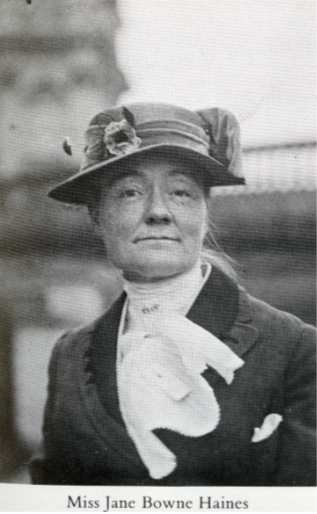
Figure 2. Jane was never married.
The School
Jane wanted the horticulture school to educate and empower women. The school provided a unique opportunity for women not only to become educated generally but to enter a field dominated by men. According to Jane “the purpose of the school is to offer educated and earnest-minded women who have a love for the country life and an aptitude for country pursuits, practical training in horticulture.”
The School was formally chartered by the Commonwealth of Pennsylvania in 1910. Classes began on February 11, 1911, with Mary D. Collins serving as principal and Miss E.D. Varley as the only instructor. Of the five students who first enrolled, three completed the two-year program. Ten new students entered in the second cohort. Classes were held from 7:30 a.m. to 4 p.m., five days a week, 10 months out of the year.

Figure 3. The original building of the Pennsylvania School of Horticulture for Women. Jane had the colonial farmhouse remodeled to provide an office, dining room, staff quarters and a classroom. The classroom was so small the teacher had to stand in the doorway to lecture. In 1915 a second building was added that included a proper classroom and dormitory space.
Haines had a “hands-on, learning-by-doing” philosophy clearly evidenced by the instruction the earliest students received at the time. In a speech to the school backers in 1910 Haines stated “One principle above all others we will keep before us and would particularly enforce — the trained hand with the trained mind, which means mastery and success.”
The “Ambler farmerettes” as the students were locally known, studied botany, horticulture, floriculture, soil chemistry, orchard care, farm management, garden design and bookkeeping. They had the option to study beekeeping, farm carpentry, dairy, or poultry. All students received practical training in the gardens, orchards and fields; two hours out-of-doors for each hour in the classroom.
The first students helped clear the land. Their use of dynamite to blow up tree stumps made the news.
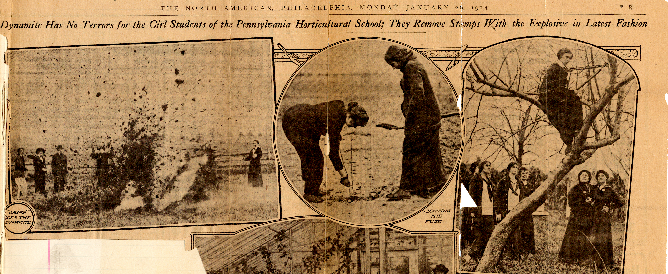
Figure 4. The North American paper in Philadelphia (January 26, 1914) showed the women working with the dynamite and pruning a tree.

Figure 5. From the Wilkes-Barre Times Leader, March 18, 1914. Note the interesting spelling of horticulture in the title. Make sure you read about the dynamite. Use CTRL+ to enlarge.
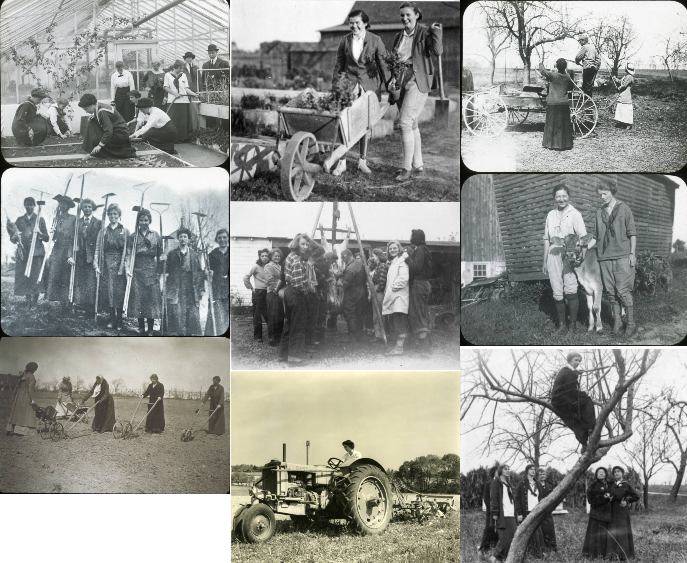
Figure 6. Campus Scenes over the years. The students with rakes are in the Woman’s Land Army. The center image is butchering a hog. Images from the Temple University Library.
Who is Louis Carter Bush-Brown?
In September of 1914 Louise Carter of New York arrived by train in Ambler to enroll in the school. She was joined by 13 other young women who enrolled that year. She stated “The students in the first two graduating classes were, in the true sense of the word, pioneers. We were venturing into a completely new field for women and had no way of knowing what opportunities the future might hold for us.”
After completing the two year program Louise taught horticulture to girls in Boston and then in Kentucky. She became an estate manager in Florida and a cooperative extension agent. She returned to Ambler in 1924 as the School’s fourth director. A year later Miss Carter married James Bush-Brown, a landscape architect, who taught the school’s landscape design course and designed the gardens at the School
Louise was director of the School until she retired in 1952. In addition to leading the School through the depression and World War II Louise and her husband co-authored several garden books. And as we learned last week, she was the founder and editor of The Farmers Digest.
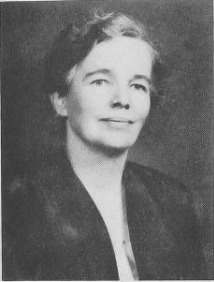
Figure 7. Louise Carter Bush-Brown.
The School did more than just educate young women. The founding of the Woman’s National Agriculture and Horticultural Association, later known as the Woman’s National Farm & Garden Association (WNF&GA) occurred at the Pennsylvania School of Horticulture for Women. During World War I the School was significantly involved in starting The Woman’s Land Army of America (see the Friday Footnote from 8/10/2018).
The Ending But Really A New Beginning
Over the years it was a challenge to keep the School going. Since it was a private school it depended on tuition and donations to operate. In 1952 it received provisional accreditation as a junior college. In 1958, after more than forty-five years as an independent institution, the school merged with Temple University and became the Temple University Ambler Campus. Men were admitted to the program for the first time.
Today the campus is part of Temple Ambler, which carries on the spirit and the work of the Pennsylvania School of Horticulture for Women through the university’s Department of Landscape Architecture and Horticulture, a program “dedicated to promoting sustainable agriculture, effective land use, and environmental awareness.”
Mary Anne Fry has a nearly unique distinction at Temple University. She is one of just eight people to ever graduate from Temple with a degree in Agriculture. As a member of the Class of 1958, she attended the Temple University Ambler Campus at a time of great transition. When she began her classes, she was attending the Pennsylvania School of Horticulture for Women. When she graduated, however, her degree read “Ambler Junior College,” which soon after became the “Ambler Campus of Temple University.”
She states (Ambler Arboretum, n,d,):
“I always felt I was in the middle of the seesaw,” she said with a laugh. “I was among the last of the ‘Aggies,’ and being an Aggie, I was assistant to the herdswoman. The campus was a very different place then; we had a herd of Jersey cows, hogs, chickens, sheep, and horses. We tended to the peach and apple orchards and field crops such as corn and wheat with the horticulture students. It was a fully working farm — we worked hard throughout the day and we loved every moment of it.”
The wonderful thing about the programs at Ambler, said Fry, was that “everything was hands-on — you had to go out and actually do it.”
“You were never just in the classroom,” she said. “One of the greatest benefits was being out in the gardens, out in the fields, out in the barn actually doing what you were learning about.”
Concluding Remarks
In the book A Century of Cultivation, Carey and Fry (2011) write:
Jane Bowne Haines was a social reformer at a time when there wasn’t very much available for women. She felt that horticulture and agriculture would be considered socially acceptable jobs for young, educated women and that it could provide them with a better future.
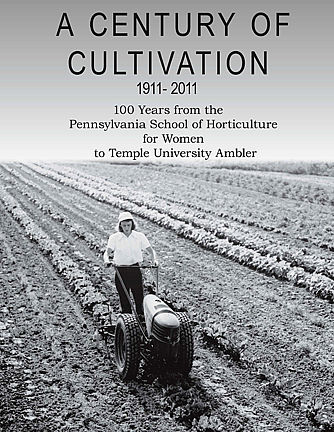
Figure 8. A Century of Cultivation
Libby (2011, p. 74) summed up the accomplishments of the Pennsylvania School of Horticulture for Women with these words:
Over the course of almost five decades, the students of the Pennsylvania School of Horticulture for Women proudly shared the accomplishments of their classmates as many of them went on to set up their own farms, nurseries, landscape design and floral businesses. They became educators, directors of schools, journalists, authors, landscape architects and leaders of public organizations. In a variety of ways, Jane B. Haines and the women of the Pennsylvania School of Horticulture made a last contribution to changing perception and value of women in the workplace…The informality of a small private occupational school such as the Pennsylvania School, established specifically for women, offered much more than career preparation. It provided an environment where young women were instructed in ways to forge their own paths in life with self-confidence and encouraged via a lasting network of mentors and supporters.
As agricultural educators we need to keep that last sentence in mind (and include young men to the sentence). We provide an environment where young women and men are instructed in ways to forge their own paths in life with self-confidence and encouraged via a last network of mentors and supporters. Agricultural and Extension Education has the same goals as did the Pennsylvania School of Horticulture for Women.
References
https://ambler.temple.edu/arboretum/about/history
Carey, Jenny Rose; Fry, Mary Anne Blair (2011). A century of cultivation 1911-2011: 100 years from the Pennsylvania School of Horticulture for Women to Temple University Ambler. Langhorne, PA: Temple University.
Libby, Valencia (2012). Cultivating Mind, Body, and Spirit: Educating the “New Women” for Careers in Landscape Architecture. In Mozingo, Louise and Jewell, Linda. (Eds.) Women in Landscape Architecture. McFarland & Company, London.
Pennsylvania Historical Marker, The Pennsylvania School of Horticulture for Women. http://explorepahistory.com/hmarker.php?markerId=1-A-130
Pickoff, Margaret (2022). Cultivating the Trained Hand and Mind: The Pennsylvania School of Horticulture for Women. https://www.womeninhorticulture.com/post/cultivating-the-trained-hand-and-mind-the-pennsylvania-school-of-horticulture-for-women
